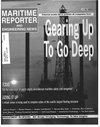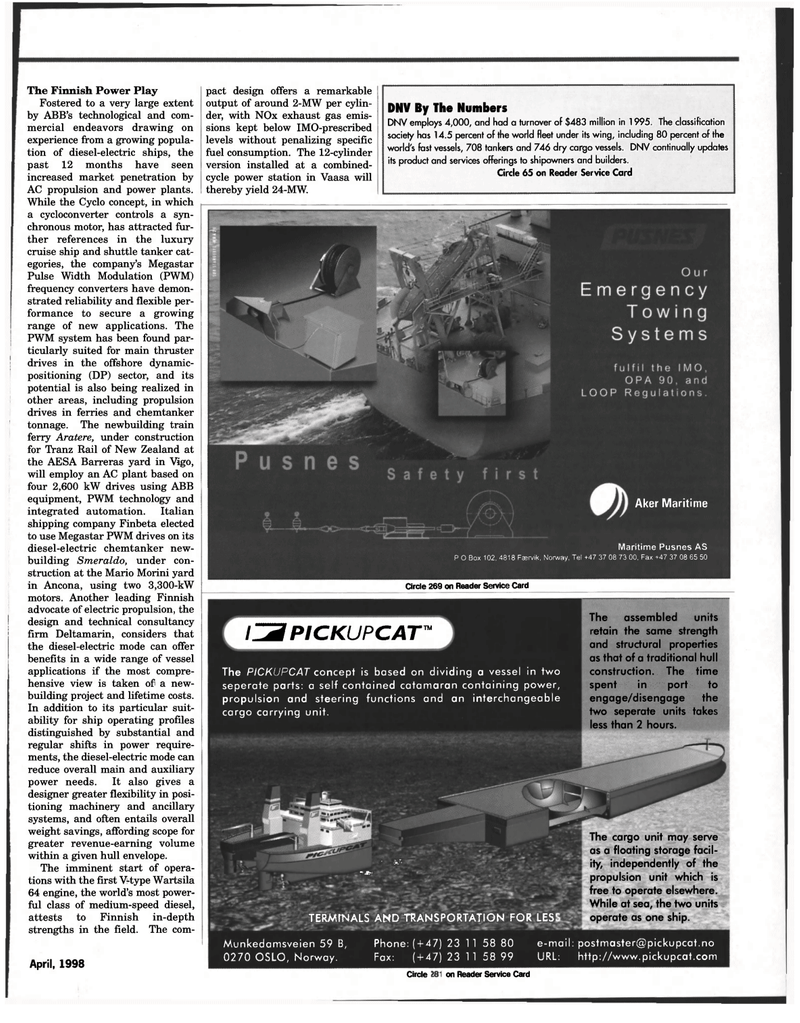
Page 93: of Maritime Reporter Magazine (April 1998)
Read this page in Pdf, Flash or Html5 edition of April 1998 Maritime Reporter Magazine
The Finnish Power Play
Fostered to a very large extent by ABB's technological and com- mercial endeavors drawing on experience from a growing popula- tion of diesel-electric ships, the past 12 months have seen increased market penetration by
AC propulsion and power plants.
While the Cyclo concept, in which a cycloconverter controls a syn- chronous motor, has attracted fur- ther references in the luxury cruise ship and shuttle tanker cat- egories, the company's Megastar
Pulse Width Modulation (PWM) frequency converters have demon- strated reliability and flexible per- formance to secure a growing range of new applications. The
PWM system has been found par- ticularly suited for main thruster drives in the offshore dynamic- positioning (DP) sector, and its potential is also being realized in other areas, including propulsion drives in ferries and chemtanker tonnage. The newbuilding train ferry Aratere, under construction for Tranz Rail of New Zealand at the AESA Barreras yard in Vigo, will employ an AC plant based on four 2,600 kW drives using ABB equipment, PWM technology and integrated automation. Italian shipping company Finbeta elected to use Megastar PWM drives on its diesel-electric chemtanker new- building Smeraldo, under con- struction at the Mario Morini yard in Ancona, using two 3,300-kW motors. Another leading Finnish advocate of electric propulsion, the design and technical consultancy firm Deltamarin, considers that the diesel-electric mode can offer benefits in a wide range of vessel applications if the most compre- hensive view is taken of a new- building project and lifetime costs.
In addition to its particular suit- ability for ship operating profiles distinguished by substantial and regular shifts in power require- ments, the diesel-electric mode can reduce overall main and auxiliary power needs. It also gives a designer greater flexibility in posi- tioning machinery and ancillary systems, and often entails overall weight savings, affording scope for greater revenue-earning volume within a given hull envelope.
The imminent start of opera- tions with the first V-type Wartsila 64 engine, the world's most power- ful class of medium-speed diesel, attests to Finnish in-depth strengths in the field. The com- pact design offers a remarkable output of around 2-MW per cylin- der, with NOx exhaust gas emis- sions kept below IMO-prescribed levels without penalizing specific fuel consumption. The 12-cylinder version installed at a combined- cycle power station in Vaasa will thereby yield 24-MW.
DNV By The Numbers
DNV employs 4,000, and had a turnover of $483 million in 1 995. The classification society has 14.5 percent of the world fleet under its wing, including 80 percent of the world's fast vessels, 708 tankers and 746 dry cargo vessels. DNV continually updates its product and services offerings to shipowners and builders.
Circle 65 on Reader Service Card
April, 1998 95
Aker Maritime
Maritime Pusnes AS
P O Box 102, 4818 Fajrvik, Norway, Tel +47 37 08 73 00, Fax +47 37 08 65 50
Circle 269 on Reader Service Card
Circle 354 on Reader Service Card
I^PICKUPCAT™
The PICKUPCAT concept is based on dividing a vessel in two seperate parts: a self contained catamaran containing power, propulsion and steering functions and an interchangeable cargo carrying unit.
The assembled units retain the same strength and structural properties as that of a traditional hull construction. The time spent in port to engage/disengage the two seperate units takes less than 2 hours. "it IT; • 4*
TERMINALS AND TRANSPORTATION FOR LES
The cargo unit may serve as a floating storage facil- ity, independently of the propulsion unit which is free to operate elsewhere.
While at sea, the two units operate as one ship.
Munkedamsveien 59 B, Phone: ( + 47) 23 1 1 58 80 e-mail: [email protected] 0270 OSLO, Norway. Fax: ( + 47)23 1 1 58 99 URL: http://www.pickupcat.com

 92
92

 94
94
